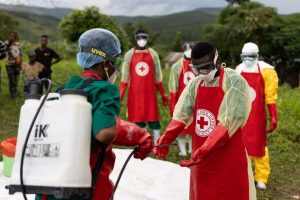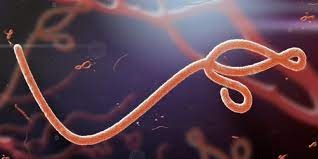The name of the virus is due to the Ebola River, geographically located in Zaire.
There are five serotypes of the Ebola virus: Ebola-Zaire, Ebola-Sudan, Ebola-Ivory Coast, and Ebola-Bundibugyo. The fifth serotype, Ebola-Reston, has caused disease in primates but not in humans. It is an infection characterized by a high mortality rate, which ranges between 50% and 95% of those affected.
Due to its lethal nature, this virus is considered as a biological weapon.
The prevalence of Ebola is difficult to determine, because it usually occurs in the form of outbreaks or epidemics, however, in countries such as the United States, infection by this virus is not endemic, although there are records of several people who work in direct contact with primates and who have acquired Ebola-Reston type infection; Fortunately, this type of virus has not shown pathogenic effects in humans. Other people at potential risk are laboratory workers who work with infected animals or tissue cultures of the virus.
Currently, people at risk of Ebola virus haemorrhagic fever are considered to be those with a history of travel to sub-Saharan Africa, people caring for infected patients, as well as workers who come into contact with infected primates of foreign origin. African.
 The Ebola virus is considered to be highly infectious, due to its high mortality rate, the rapidity with which it causes death, and the remote areas where infections occur. It is transmitted to humans through contact with a living or dead infected host animal and spread from person to person by contact with the blood, tissues, secretions, and body fluids of the infected individual, and by contact with contaminated medical equipment. such as needles.
The Ebola virus is considered to be highly infectious, due to its high mortality rate, the rapidity with which it causes death, and the remote areas where infections occur. It is transmitted to humans through contact with a living or dead infected host animal and spread from person to person by contact with the blood, tissues, secretions, and body fluids of the infected individual, and by contact with contaminated medical equipment. such as needles.
Ebola virus infections are acute and there is no “carrier” state.
Because the natural reservoir of the virus is unknown, how the virus first appears in a human at the start of an outbreak has not yet been determined.
Nosocomial transmission refers to the spread of a disease within a hospital setting, this type of transmission frequently occurs during Ebola virus outbreaks. In most health centers in Africa, patients are seen without masks, gowns or gloves. Also, when the needles or syringes used may not be of the disposable type, if they become contaminated with the virus and then reused, many people can become infected.
In fact, if the death of the person affected by the virus occurs, the protocol indicates that an autopsy cannot be performed due to the high risk of contagion from the victim’s fluids, so it must be cremated.
Fever, headache, muscle aches are some symptoms of Ebola infection.
The incubation period for this disease ranges between two and 21 days, after which the onset of Ebola symptoms occurs, although the most common is that they appear between the eighth and tenth days: High and sudden fever; diarrhea, vomiting, and stomach pain; headache; joint discomfort and severe muscle pain; sore throat and generalized weakness; appearance of a reddish rash on the skin; Red eyes; among other complications.
Why some people are able to recover from Ebola and others are not remains a mystery to scientists.
A blood count can help detect the presence of the Ebola virus in the blood.
There are specific laboratory tests that allow detecting the presence of the Ebola virus in blood or serum, especially in the acute phase, such as the determination of genomic or subgenomic RNA; however, the most common technique to determine infection by this virus is the detection of IgM and IgG antibodies by the capture or sandwich ELISA method, this technique is an immunological test that is based on the capture of antibodies present in the serum from the patient when they react with a virus protein attached to a well of a rectangular plate made of polystyrene, a special type of plastic.
The Ebola patient may require intravenous fluid administration.
There is currently no drug directed at combating the Ebola virus, therefore only symptomatic treatment or supportive measures can be performed. Among them we have: for fever, administer Acetaminophen, never take Aspirin. due to the risk that exists of hemorrhagic manifestations; You should also drink plenty of fluids to avoid dehydration and rest in bed.
If the patient has hemorrhagic manifestations, they will require intravenous administration of fluids, as well as platelet concentrate, coagulation factors or blood transfusions if there are significant losses.
Due to the virulent Ebola-Zaire outbreak in West Africa, some patients were treated with an experimental serum known as ZMapp. Since then, other pharmaceutical companies have been working against the clock to find a cure or an effective vaccine to fight this virus. Meanwhile, some patients were administered, with positive results in some cases, hyperimmune serum (blood plasma) obtained from patients who have managed to overcome the disease, so their blood has generated antibodies to fight the infection.
According to the recommendations of the World Health Organization (WHO), the control and prevention of the Ebola virus is based on three fundamental pillars:
- Control infection in animals: there are currently no vaccines aimed at preventing Ebola-Reston virus infection in animals, which is why chemical disinfection methods must be applied using sodium hypochlorite and other detergents on a regular basis in farms. animals like monkeys and pigs. If any outbreak of the virus is suspected, animals should be quarantined or may even be euthanized to prevent transmission to humans.
- Reduce the risk of human infection: as there is no vaccine for human beings nor a specific treatment against Ebola virus infection, education of the population at risk is a fundamental weapon. Awareness campaigns should be implemented on the different risk factors and protection measures against them. Reduce contact with wild animals that may be infected, such as apes, monkeys, and some types of bats. Avoid eating raw meat.
- Use of gloves and protective clothing to handle animals.
- Use special gloves, masks and gowns to reduce the risk of person-to-person transmission as a result of close contact with infected people, particularly with their body fluids.
- Wash your hands frequently, especially after visiting sick family members in the hospital, as well as after caring for the sick at home.
- Disseminate information messages to the population about the characteristics of the disease and the measures to control the outbreak, in particular the burial of corpses.
Prevent Ebola infection in health centers: this refers to the use of isolation measures and the use of necessary equipment (gloves, face masks, gowns) to reduce the risk of transmission from patients to health personnel, such as doctors, nurses, as well as laboratory technicians who handle blood and other body fluids from patients infected with the virus.








